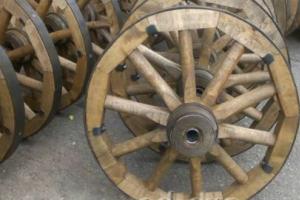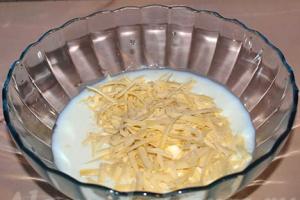One of the most complex and yet widespread mechanical systems is the gear train. It is a great way to transfer mechanical energy from one place to another and a way to increase or decrease power (torque) or increase or decrease the speed of something.
How to make a gear with your own hands? The problem is always that creating effective gears requires quite a lot of drawing and math skills, as well as the ability to create complex parts.
For an amateur there is no need to have maximum efficiency, so we can get a much easier system to make, even with the tools at hand.
A gear is a series of teeth on a wheel. (Note in the diagram above, they labeled the wrong number of teeth on the gears - sorry)
Step 1: Formulas and Calculations

Formulas for drawing and making gear teeth can be found in abundance on the Internet, but for a beginner they seem very complicated.
I decided to simplify the problem and the solution works very well on both large and small scales. On a small scale it is best suited for machine cutting using laser cutters For example, very small gears can be successfully manufactured in this way.
Step 2: Easy way
So, the shape of the prong, to put it simply, can be a semicircle.
Step 3: Determine the dimensions

Now we can define the parameters to make the gear:
- How big/small the gear teeth will be (diameter) - the smaller the gear, the smaller the teeth should be.
- All the teeth that are assembled into the mesh (connected) must be the same size, so you need to calculate the smaller gear first.
Let's start with 10mm teeth.
I want a gear with 5 teeth so that the circle is 10x10mm (in circumference) = 100mm.
To draw this circle I need to find the diameter, so I use math and a calculator and divide the circumference (100mm) by Pi = 3.142.
This gives me a diameter of 31.8mm and I can draw this circle using a compass and then draw exactly 10 circles of 10mm diameter on its circumference using a compass.
If you have the option, it's easier to do everything using drawing software. If you are using software, you will need to be able to rotate the circles of teeth around the main circle, and you will need to know how far to rotate each tooth. It's easy to calculate: divide 360 degrees by the number of circles. So for our 10 circles, 360/10 = 36 degrees for each tooth.
Step 4: Making a Scalloped Shape

Remove the top of one circle and the bottom of the next circle. To do this you must have an even number of teeth
We have the first gear. It can be cut from wood or metal using basic tools, saws and files.
This process is easy to repeat for as many gears as you need. Keep the size of the circle consistent and they will fit together.
Step 5: Get the Gear

Since these semi-circular gears are easy to cut, you can make them using a tool and a jigsaw or saw.
I used to make a 9 or 10 tooth template on plywood and used that as a guide for my hand router and cut the gears without any problems.
If you have access to a laser cutter, they can be cut from 3 or 5mm thick acrylic and come in very small sizes.
Nowadays, there are a lot of mechanisms around us that use plastic gears. Moreover, it can be like toy cars, and quite serious things, for example, an antenna lift in a car, a spinning rod gearbox, etc. The reasons for gear failure can be different, of course, most of them are related to improper operation, but that’s not about that now. If you find yourself in such a situation and a couple of gear teeth are broken, then there is a way out: not to pay for an expensive part, but to restore it in a simple way.
Needed for recovery
- Unnecessary toothbrush.
- Detergent.
- Two-component epoxy adhesive - cold welding for plastic.
Restoring a plastic gear
Preparation
The first step is to prepare the surface of the gear. We wash it several times warm water With detergent, actively working with a toothbrush. Our task is to degrease and remove grease from all edges.After degreasing is done, dry it dry.
Preparing the glue
Now let's prepare the glue. Mix the components on a small piece of cardboard in the proportions as in the instructions. Mix well.In general, before opening the glue, I recommend that you carefully read its instructions, especially with the time of complete and partial hardening, since these data may differ radically from different manufacturers.
If the consistency turns out to be liquid, let it stand for a while until it begins to harden.
Restoration of teeth
In my case, several teeth were ground down, the situation can be corrected. Apply glue to the place that needs to be restored. The glue should be very thick, but flexible.
We make such a peculiar tubercle.


We place the gear on an improvised stand so that the glue thickens even more. Again, everything is individual, I personally needed about 20 minutes for the consistency to noticeably thicken.

You can speed up the reaction and reduce the thickening time by heating. For example, take a hairdryer and start heating the glue on the gear.

Restoration of teeth
Now the most crucial moment is rolling the teeth. The unit where the gear was used, namely the other gear with which our broken one was in direct contact, must be generously lubricated with grease, grease or lithol.We install the broken gear and roll it over the other one several times.


As a result, another gear will roll the track on the thick glue.


Now you understand that before rolling the teeth, the epoxy glue on the gear must cure to the consistency of hard clay.
Thanks to the lubrication, the glue will not stick to the other gear.
Hardening
Carefully remove the restored product from the mechanism and leave it for final hardening, usually for a day.
In this simple way, you can quite easily restore broken gears.
How to replace epoxy glue?
If you haven't found glue, I can recommend you to make a slightly similar composition.For this you will need:
- Epoxy resin with hardener.
- The cement is dry.
In the proportion specified in the instructions, mix the components to obtain the required amount of glue. Add cement. Just not a cement-sand mixture, but pure cement. The proportions are approximately two to one. That is, two parts glue and one part cement. And mix everything very thoroughly. The glue is ready, and then everything is as per the instructions above.
Owners of home workshops have many devices and devices that make it much easier manual labor and improve work efficiency. One such mechanism is a reduction gearbox.
It is mainly used to change the rotation speed of the output shaft downward or increase the torque on it. By its design, this device can be combined, worm or gear, as well as single- and multi-stage.
Many people make a reduction gearbox with their own hands.
What is a gearbox?
This mechanism is a transmission link that is located between the rotational devices of an electric motor or internal combustion engine to the final operating unit.
The main characterizing indicators of the gearbox are:
- transmitted power;
- number of driving and driven rotary shafts.
To the rotational devices of this mechanism fixedly fix gear or worm gears, which transmit and regulate movement from one to another. The housing has holes with bearings on which the shafts are located.
Required materials and tools
To make a gearbox you may need following materials and tools:
- wrenches and screwdrivers of various shapes and sizes;
- files, drills;
- rubber gaskets;
- washers, pipe cuttings, gears, bolts, bearings, pulleys, shafts;
- inverter;
- caliper, ruler;
- pliers;
- vice, hammer;
- frame from an old gearbox or steel sheets.
How to make a gearbox with your own hands?
Most important detail The reduction gearbox is considered to have its housing. It must be designed and manufactured correctly with your own hands, since the relative position of the shafts and axes, the alignment of the seats for the support bearings and the gaps between the gears depend on this.
Industrial gear housings made mainly by casting from aluminum alloys or cast iron However, this is completely impossible to do at home. Therefore, you can select or modify a ready-made housing to suit your needs, or weld it from a steel sheet. Only in this case should you remember that during the welding process the metal can “lead”, and therefore, to maintain the alignment of the shafts, it is necessary to leave an allowance.
Many masters do it differently. In order not to bother with boring work, they begin to weld the body completely, and instead of sockets for support bearings, pipe sections are used, which are set in the required position and only after that are finally secured in place by welding or bolts. To facilitate maintenance of the gearbox, it is necessary to make the housing removable top cover, and at the bottom there is a drain hole that will be used to drain used oil.
The gears are supported by the axles and shafts of the gearbox. Typically, in a single-stage mechanism, only shafts with rigidly mounted gears are used. In this case, both gears rotate together with their shafts. The axle is used when it is necessary to insert an intermediate gear into the gearbox.
She begins to rotate freely on its axis with minimal clearance, and so that it does not move sideways, it is fixed with a nut, a thrust collar or locking split washers.
Shafts should be made of steel, which has good strength and excellent machinability.
The bearings in the gearbox serve as supports for the shafts. They perceive the loads that arise during the operation of the mechanism. The reliability and performance of the gearbox depends entirely on how correctly the bearings were selected.
For the mechanism with your own hands best choice of bearings closed type , which require minimal maintenance. They are lubricated with grease. The type of bearings directly depends on the type of load.
When using spur gears, ordinary single or double row ball bearings will suffice.
If the mechanism contains helical gears or worm gears, then an axial load begins to be transmitted to the shaft and bearings, which requires the presence of a ball or roller angular contact bearing.
Another quite important part of the gearbox is the gears. Thanks to them, you can change the rotation speed of the output shaft. To make gears, you need special metal-cutting equipment, so to save money you can use ready-made parts from decommissioned devices.
It is very important during the installation of gears to set the correct gap between them, because the noise level that occurs during operation of the gearbox and the load capacity depend on this. It is best to lubricate the gears with liquid industrial oil, which is poured in such a way that it covers the teeth of the lower gear. The remaining parts are lubricated by spraying oil throughout the internal cavity of the mechanism.
Shaft seals prevent oil from leaking out of the gearbox. They are installed at the shaft outputs and secured in bearing caps.
To prevent emergency destruction of mechanism parts from heavy loads, a safety clutch is used. It comes in the form of a bellows, spring-loaded friction discs or a shear pin.
Installation process Bearing caps make them very light, which can be through or blind. They are selected from ready-made parts or turned on a lathe.
Scope of application of the gearbox
This mechanism is indispensable assistants in various spheres of human activity. Typically it is used:
- in industry;
- in automobile gearboxes;
- in electrical equipment and household appliances;
- in the gas industry and many other industries.
This mechanism is used very widely in industry. In various processing machines it is used as a rotary transmission part, increasing the speed of revolutions.
But in automobile gearboxes, the gearbox, on the contrary, reduces the engine speed. The smoothness and softness of the transport depends on how correctly its adjustment is done.
This speed reduction device is also used in household appliances and electrical equipment with electric motors. These could be mixers, washing machines, drills, food processors, grinders.
Gearboxes are an indispensable part of ventilation equipment, treatment facilities, pumping systems. They contribute to maintaining optimal pressure gas in gas-flame installations.
The gas production industry also cannot do without this mechanism. Transportation and storage of gases is a rather dangerous process, so a reducer is used to block the access of gas or open its outlet by adjusting the pressure.
Assembling a gearbox with your own hands from available materials is quite a troublesome task, but not too difficult. With its help, the rotation of the output shaft is reduced and its torque is increased. The performance of the devices or machine completely depends on this part. This mechanism is used in a wide variety of human activities.
- Fedor Ilyich Artyomov
For the manufacture of gears, the following materials are used: iron, cast iron, bronze, simple carbon steel, special steel compositions with an admixture of chromium, nickel, vanadium. In addition to metals, softening materials are used: leather, fiber, paper, they soften and reduce noise. But metal gears can also operate silently if their profile is made with precision. For rough gears, “power” gears are produced; they are made by casting from cast iron and steel without further processing. “Running” gears for high-speed gears are manufactured on milling or gear-cutting machines, followed by heat treatment - carburizing, which makes the teeth hard and resistant to wear. After carburization, the gears are processed on grinding machines.
Running method
The rolling method is the most common option for manufacturing gears, since this method is the most technologically advanced. In this manufacturing method, the following tools are used: cutter, hob, comb.
Rolling method using a cutter
For the manufacture of gears, a gear shaping machine with a special cutter is used (a gear equipped with cutting edges). The procedure for manufacturing gears takes place in several stages, since it is not possible to cut off the entire excess layer of metal at one time. When processing a workpiece, the cutter performs a reciprocating movement and after each double stroke, the workpiece and the cutter rotate one step, as if “rolling” over each other. When the gear blank makes a full revolution, the cutter performs a feed motion towards the workpiece. This production cycle is carried out until all the required metal layer has been removed.
Rolling method using a comb
The comb is a cutting tool, its shape is similar to a rack, but one side of the comb teeth is sharpened. The blank of the gear being manufactured produces a rotational movement around its axis. And the comb performs a translational movement perpendicular to the axis of the gear and a reciprocating movement parallel to the axis of the wheel (gear). Thus, the comb removes the excess layer across the entire width of the gear rim. Another option for the movement of the cutting tool and the gear blank relative to each other is possible, for example, the workpiece performs a complex intermittent movement, coordinated with the movement of the comb, as if the profile of the cut teeth is engaging with the contour of the cutting tool.
 This method allows you to produce a gear using a hob cutter. Cutting tool In this method, a hob cutter is used, which, together with the gear blank, produces a worm gear.
This method allows you to produce a gear using a hob cutter. Cutting tool In this method, a hob cutter is used, which, together with the gear blank, produces a worm gear.
 One gear cavity is cut with a disk or finger cutter. The cutting part of the cutter, made in the shape of this cavity, cuts the gear. And with the assistance of the dividing device, the gear being cut is rotated by one angular step and the cutting process is repeated. This method of manufacturing gears was used at the beginning of the twentieth century, it is not accurate, the cavities of the produced gear are different, not identical.
One gear cavity is cut with a disk or finger cutter. The cutting part of the cutter, made in the shape of this cavity, cuts the gear. And with the assistance of the dividing device, the gear being cut is rotated by one angular step and the cutting process is repeated. This method of manufacturing gears was used at the beginning of the twentieth century, it is not accurate, the cavities of the produced gear are different, not identical.
Hot and cold rolling
In this method of producing gears, a gear-rolling tool is used, which heats a certain layer of the workpiece to a plastic state. After this, the heated layer is deformed to obtain teeth. And then the teeth of the gear being manufactured are rolled until they acquire the exact shape.
Manufacturing of bevel gears
For the manufacture of bevel wheels (bevel gears), a variant of running in the machine gearing of the workpiece with an imaginary producing wheel is used. The cutting edges of the tool cut off the allowance during the main movement, thus forming side surfaces future gear (gear).
Hello dear visitors. We invite you to watch the video tutorial on how to make a plastic gear. As you know, many gears in household and office equipment are made of plastic, and this gear can also break. You can learn how to make a new one based on the model that is available.
In this tutorial you will learn how to make a broken gear from a food processor. As you understand, such gears cannot be bought in stores; repair shops may simply not find a suitable gear. Making a metal gear will be a bit expensive for this model of food processor.
To create a new plastic gear, we need to use the broken part, but first we will need to glue it together. When assembling a broken gear, we may not encounter any major difficulties - the appearance of small defects, or the possibility of not being able to get small parts.
We glue all this together with ordinary superglue, since we don’t need any extra strength. It is necessary to make all the parts into one kind of gear. When gluing, we see small defects that we have. Small parts simply flew apart when the gear broke. Accordingly, we will need to replenish everything and all this will be done with wax. We fill in everything where these parts are missing, pieces of plastic with wax and model them as the missing part would look like. If this part of the part is convex, then we will model it as convex, and if it is flat, then as flat.
When restoring the gear, you need to try to make it the way it was originally in the food processor. Of course, when done with wax, we will not be able to make an exact copy of the gear, but we will try to make a more or less exact copy. When using such gears in food processors, there is no such ultra-precise fit, since it is constantly taken off and put on.
This wax modeling process takes an average of a couple of hours. After modeling to the desired state, you can safely begin the process of manufacturing a plastic gear. In the training video you can watch in more detail the entire process of creating such a gear. We wish you good luck.








